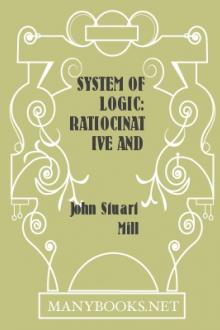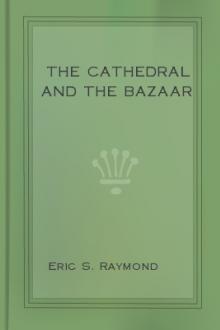A System of Logic: Ratiocinative and Inductive, John Stuart Mill [best books to read now .txt] 📗

- Author: John Stuart Mill
- Performer: -
Book online «A System of Logic: Ratiocinative and Inductive, John Stuart Mill [best books to read now .txt] 📗». Author John Stuart Mill
§ 6. We can now understand how an experimental may transform itself into a deductive science by the mere progress of experiment. In an experimental science, the inductions, as we have said, lie detached, as, a a mark of b, c a mark of d, e a mark of f, and so on: now, a new set of instances, and a consequent new induction, may at any time bridge over the interval between two of these unconnected arches; b, for example, may be ascertained to be a mark of c, which enables us thenceforth to prove deductively that a is a mark of c. Or, as sometimes happens, some comprehensive induction may raise an arch high in the air, which bridges over hosts of them at once: b, d, f, and all the rest, turning out to be marks of some one thing, or of things between which a connexion has already been traced. As when Newton discovered that the motions, whether regular or apparently anomalous, of all the bodies of the solar system, (each of which motions had been inferred by a separate logical operation, from separate marks,) were all marks of moving round a common centre, with a centripetal force varying directly as the mass, and inversely as the square of the distance from that centre. This is the greatest example which has yet occurred of the transformation, at one stroke, of a science which was still to a great degree merely experimental, into a deductive science.
Transformations of the same nature, but on a smaller scale, continually take place in the less advanced branches of physical knowledge, without enabling them to throw off the character of experimental sciences. Thus with regard to the two unconnected propositions before cited, namely, Acids redden vegetable blues, Alkalies make them green; it is remarked by Liebig, that all blue colouring matters which are reddened by acids (as well as, reciprocally, all red colouring matters which are rendered blue by alkalies) contain nitrogen: and it is quite possible that this circumstance may one day furnish a bond of connexion between the two propositions in question, by showing that the antagonistic action of acids and alkalies in producing or destroying the colour blue, is the result of some one, more general, law. Although this connecting of detached generalizations is so much gain, it tends but little to give a deductive character to any science as a whole; because the new courses of observation and experiment, which thus enable us to connect together a few general truths, usually make known to us a still greater number of unconnected new ones. Hence chemistry, though similar extensions and simplifications of its generalizations are continually taking place, is still in the main an experimental science; and is likely so to continue unless some comprehensive induction should be hereafter arrived at, which, like Newton's, shall connect a vast number of the smaller known inductions together, and change the whole method of the science at once. Chemistry has already one great generalization, which, though relating to one of the subordinate aspects of chemical phenomena, possesses within its limited sphere this comprehensive character; the principle of Dalton, called the atomic theory, or the doctrine of chemical equivalents: which by enabling us to a certain extent to foresee the proportions in which two substances will combine, before the experiment has been tried, constitutes undoubtedly a source of new chemical truths obtainable by deduction, as well as a connecting principle for all truths of the same description previously obtained by experiment.
§ 7. The discoveries which change the method of a science from experimental to deductive, mostly consist in establishing, either by deduction or by direct experiment, that the varieties of a particular phenomenon uniformly accompany the varieties of some other phenomenon better known. Thus the science of sound, which previously stood in the lowest rank of merely experimental science, became deductive when it was proved by experiment that every variety of sound was consequent on, and therefore a mark of, a distinct and definable variety of oscillatory motion among the particles of the transmitting medium. When this was ascertained, it followed that every relation of succession or coexistence which obtained between phenomena of the more known class, obtained also between the phenomena which corresponded to them in the other class. Every sound, being a mark of a particular oscillatory motion, became a mark of everything which, by the laws of dynamics, was known to be inferrible from that motion; and everything which by those same laws was a mark of any oscillatory motion among the particles of an elastic medium, became a mark of the corresponding sound. And thus many truths, not before suspected, concerning sound, become deducible from the known laws of the propagation of motion through an elastic medium; while facts already empirically known respecting sound, become an indication of corresponding properties of vibrating bodies, previously undiscovered.
But the grand agent for transforming experimental into deductive sciences, is the science of number. The properties of numbers, alone among all known phenomena, are, in the most rigorous sense, properties of all things whatever. All things are not coloured, or ponderable, or even extended; but all things are numerable. And if we consider this science in its whole extent, from common arithmetic up to the calculus of variations, the truths already ascertained seem all but infinite, and admit of indefinite extension.
These truths, though affirmable of all things whatever, of course apply to them only in respect of their quantity. But if it comes to be discovered that variations of quality in any class of phenomena, correspond regularly to variations of quantity either in those same or in some other phenomena; every formula of mathematics applicable to quantities which vary in that particular manner, becomes a mark of a corresponding general truth respecting the variations in quality which accompany them: and the science of quantity being (as far as any science can be) altogether deductive, the theory of that particular kind of qualities becomes, to this extent, deductive likewise.
The most striking instance in point which history affords (though not an example of an experimental science rendered deductive, but of an unparalleled extension given to the deductive process in a science which was deductive already), is the revolution in geometry which originated with Descartes, and was completed by Clairaut. These great mathematicians pointed out the importance of the fact, that to every variety of position in points, direction in lines, or form in curves or surfaces (all of which are Qualities), there corresponds a peculiar relation of quantity between either two or three rectilineal co-ordinates; insomuch that if the law were known according to which those co-ordinates vary relatively to one another, every other geometrical property of the line or surface in question, whether relating to quantity or quality, would be capable of being inferred. Hence it followed that every geometrical question could be solved, if the corresponding algebraical one could; and geometry received an accession (actual or potential) of new truths, corresponding to every property of numbers which the progress of the calculus had brought, or might in future bring, to light. In the same general manner, mechanics, astronomy, and in a less degree, every branch of natural philosophy commonly so called, have been made algebraical. The varieties of physical phenomena with which those sciences are conversant, have been found to answer to determinable varieties in the quantity of some circumstance or other; or at least to varieties of form or position, for which corresponding equations of quantity had already been, or were susceptible of being, discovered by geometers.
In these various transformations, the propositions of the science of number do but fulfil the function proper to all propositions forming a train of reasoning, viz. that of enabling us to arrive in an indirect method, by marks of marks, at such of the properties of objects as we cannot directly ascertain (or not so conveniently) by experiment. We travel from a given visible or tangible fact, through the truths of numbers, to the facts sought. The given fact is a mark that a certain relation subsists between the quantities of some of the elements concerned; while the fact sought presupposes a certain relation between the quantities of some other elements: now, if these last quantities are dependent in some known manner upon the former, or vice versâ, we can argue from the numerical relation between the one set of quantities, to determine that which subsists between the other set; the theorems of the calculus affording the intermediate links. And thus one of the two physical facts becomes a mark of the other, by being a mark of a mark of a mark of it.
CHAPTER V.OF DEMONSTRATION, AND NECESSARY TRUTHS.
§ 1. If, as laid down in the two preceding chapters, the foundation of all sciences, even deductive or demonstrative sciences, is Induction; if every step in the ratiocinations even of geometry is an act of induction; and if a train of reasoning is but bringing many inductions to bear upon the same subject of inquiry, and drawing a case within one induction by means of another; wherein lies the peculiar certainty always ascribed to the sciences which are entirely, or almost entirely, deductive? Why are they called the Exact Sciences? Why are mathematical certainty, and the evidence of demonstration, common phrases to express the very highest degree of assurance attainable by reason? Why are mathematics by almost all philosophers, and (by some) even those branches of natural philosophy which, through the medium of mathematics, have been converted into deductive sciences, considered to be independent of the evidence of experience and observation, and characterized as systems of Necessary Truth?
The answer I conceive to be, that this character of necessity, ascribed to the truths of mathematics, and even (with some reservations to be hereafter made) the peculiar certainty attributed to them, is an illusion; in order to sustain which, it is necessary to suppose that those truths relate to, and express the properties of, purely imaginary objects. It is acknowledged that the conclusions of geometry are deduced, partly at least, from the so-called Definitions, and that those definitions are assumed to be correct representations, as far as they go, of the objects with which geometry is conversant. Now we have pointed out that, from a definition as such, no proposition, unless it be one concerning the meaning of a word, can ever follow; and that what apparently follows from a definition, follows in reality from an implied assumption that there exists a real thing conformable thereto. This assumption, in the case of the definitions of geometry, is false: there exist no real things exactly conformable to the definitions. There exist no points without magnitude; no lines





Comments (0)